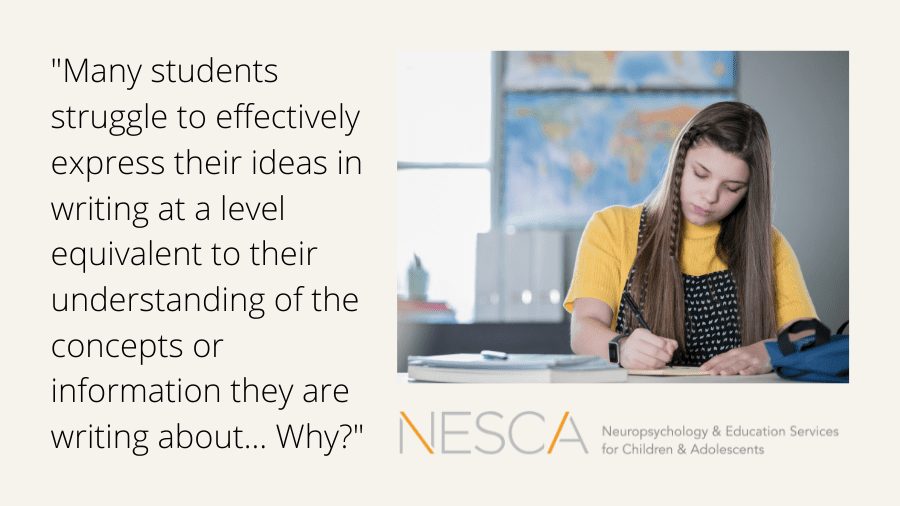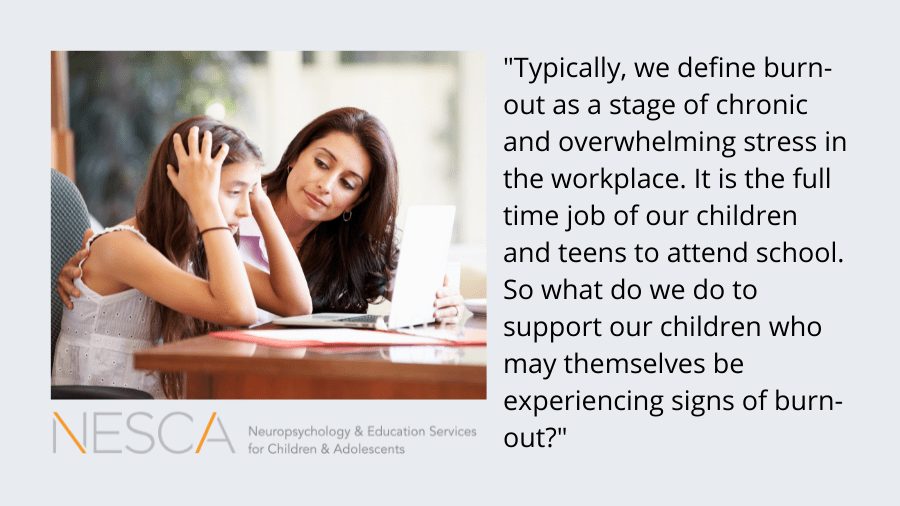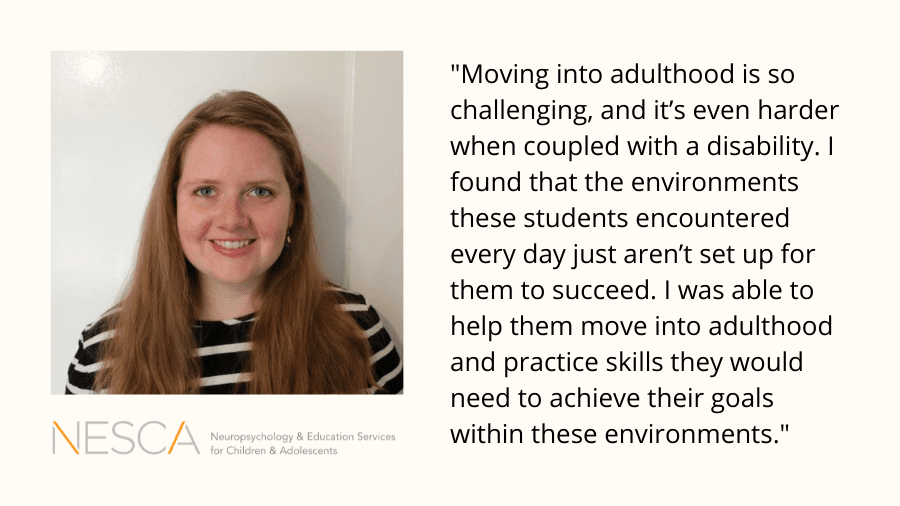
 By: Moira Creedon, Ph.D.
By: Moira Creedon, Ph.D.
Pediatric Neuropsychologist, NESCA
During intake and feedback meetings with families, I find the same question comes up often from parents: what do I tell my child about all of this? NESCA’s Dr. Erin Gibbons gracefully tackled how to prepare your child for their neuropsychological evaluation. After an evaluation is done, you as a parent now have more than 20 pages of historical information, test descriptions, tables, summaries, and recommendations. How do you translate that information into something a child or teen will actually understand? It does not need to be a secret code or a hidden message. Feedback about a child’s strengths and weakness can be an incredibly powerful intervention.
Let’s take a page from Carol Dweck’s work and use a growth mindset to frame the experience. A growth mindset tells us that skills can be learned and neural connections can be strengthened. I advise parents to tell children and teens that testing is a chance for a “healthy check-up” for our brain and our learning, just the same way that the pediatrician performs a yearly healthy check-up for our bodies. The same way that a doctor pays attention to how all of our systems grow and interact with each other, a neuropsychologist can see how a child or teen is growing and how parts of the brain can talk to each other. I shape the dialogue right away that this kind of evaluation can tell us how strong some of the parts of our learning are, like a super strong muscle that has been exercised and practiced with gusto. The evaluation can also tell us what muscles or parts of our learning are a little weaker and need some more “exercise.” Pulling in a growth mindset, we can set the frame that any weakness can be made stronger if we have the right types of exercise, the right amount of practice, the right coaches, and a willingness to work hard. Most children and teens are pretty savvy and can often predict what their weak muscles are (e.g., “math is so hard!”; “I can’t spell!”; or “I can’t pay attention in school and I’m always in trouble for getting out of my seat!”).
Now, back to those 20-plus pages of dense text. It’s rarely helpful for a child or teen to read each page. There are parts of the normal curve, standard scores, confidence intervals, on and on that children and teens have not even learned yet! Those scores are an incredibly important source of information for schools, pediatricians, psychiatrists, therapists, and other neuropsychologists. They are not nearly as helpful when sharing information with children and teens, so do not stress about trying to translate it for kids. It is also not as helpful to have this conversation with your children when you are late for a meeting or they cannot find a soccer cleat on the way to practice. Plan your conversation for a time when your stress level is low as a parent and your child or teen is also more relaxed.
Your neuropsychologist can help you in your personal feedback meeting to identify a few important strengths to share with your child or teen – from your child’s positive attitude, to their strong decoding of new words, to their memory for things they see, to their ability to make and keep friends. With a sense of confidence about their strengths, I share what the “weaker muscle” is using language like, “I can see that word problems can be harder for you,” or “Keeping your anxious thoughts quiet when you are at school so you can concentrate on schoolwork is really hard.” Most of the time, children and teens find this validating rather than shaming – finally someone sees that their struggle is not their fault, not because their brain is wrong or bad, not because they are not trying hard enough. They just need more of the right kind of practice.
Knowing their strengths and their weaknesses, it is much easier to shape the game plan for the future. I tell children and teens that the good news is that we know what strategies can help make that weaker area even stronger. So choose your metaphor: coaches have different plays or practices, music teachers have different pieces for someone to play, artists can try out a new medium or set of supplies, or gamers practice different strategies and read tips and tricks from other gamers. By choosing a relatable experience for your child or teen in that moment, we can make the information both relevant and accessible. Your neuropsychologist can speak with you about how you as a parent can share this information with your child, or they can arrange a time to share the information directly from neuropsychologist to client. It is helpful for you to listen, too, so you can hear the language used by the neuropsychologist. Be prepared that these meetings are not very long to suit a child or teen’s attention span. Children and teens need time to process the information the same way adults do. You might expect a child to return to you a few days later with questions, or for the topic to more organically arise when your teen faces a challenge. Feedback is a unique chance for your child to feel validated, encouraged, and empowered!
About the Author
Dr. Creedon has expertise in evaluating children and teens with a variety of presenting issues. She is interested in uncovering an individual’s  unique pattern of strengths and weaknesses to best formulate a plan for intervention and success. With experiences providing therapy and assessments, Dr. Creedon bridges the gap between testing data and therapeutic services to develop a clear roadmap for change and deeper of understanding of individual needs.
unique pattern of strengths and weaknesses to best formulate a plan for intervention and success. With experiences providing therapy and assessments, Dr. Creedon bridges the gap between testing data and therapeutic services to develop a clear roadmap for change and deeper of understanding of individual needs.
If you are interested in booking an evaluation with Dr. Creedon or another NESCA neuropsychologist, please fill out and submit our online intake form.
Neuropsychology & Education Services for Children & Adolescents (NESCA) is a pediatric neuropsychology practice and integrative treatment center with offices in Newton and Plainville, Massachusetts, and Londonderry, New Hampshire, serving clients from preschool through young adulthood and their families. For more information, please email info@nesca-newton.com or call 617-658-9800.






 meaningful skills in order to reach their goals. She has spent the majority of her career working in a private school for students with ASD. She has also spent some time working in an inpatient mental health setting. Lyndsay uses occupation-based interventions and strategies to develop life skills, executive functioning, and emotional regulation. While completely her doctoral degree at MGH Institute of Health Professions, Lyndsay worked with the Boston Center for Independent Living to evaluate transition age services. She uses the results from her research to deliver services in a way that is most beneficial for clients. Specifically, she focuses on hands-on, occupation-based learning that is tailored the client’s goals and interests.
meaningful skills in order to reach their goals. She has spent the majority of her career working in a private school for students with ASD. She has also spent some time working in an inpatient mental health setting. Lyndsay uses occupation-based interventions and strategies to develop life skills, executive functioning, and emotional regulation. While completely her doctoral degree at MGH Institute of Health Professions, Lyndsay worked with the Boston Center for Independent Living to evaluate transition age services. She uses the results from her research to deliver services in a way that is most beneficial for clients. Specifically, she focuses on hands-on, occupation-based learning that is tailored the client’s goals and interests.
 complex, inter-related needs, with a particular emphasis on identifying co-occurring neurodevelopmental and psychiatric challenges. She specializes in the evaluation of developmental disabilities including autism spectrum disorder and social-emotional difficulties stemming from mood, anxiety, attachment and trauma-related diagnoses. She often assesses children who have “unique learning styles” that can underlie deficits in problem-solving, emotion regulation, social skills and self-esteem.
complex, inter-related needs, with a particular emphasis on identifying co-occurring neurodevelopmental and psychiatric challenges. She specializes in the evaluation of developmental disabilities including autism spectrum disorder and social-emotional difficulties stemming from mood, anxiety, attachment and trauma-related diagnoses. She often assesses children who have “unique learning styles” that can underlie deficits in problem-solving, emotion regulation, social skills and self-esteem.
Connect with Us